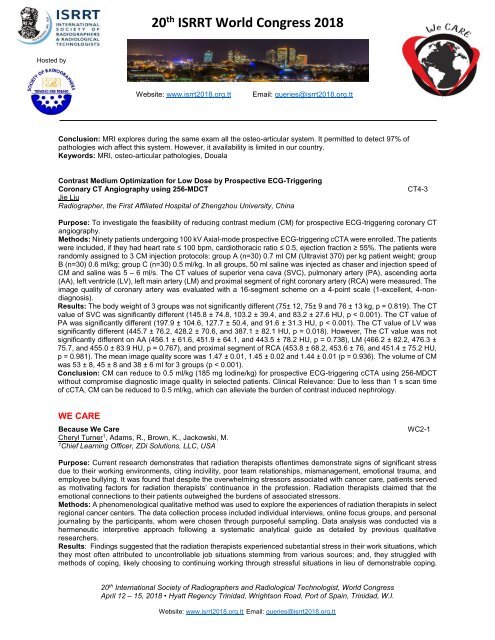Trinidad-and-Tabago-Congerss-Abstract-Book
Create successful ePaper yourself
Turn your PDF publications into a flip-book with our unique Google optimized e-Paper software.
20 th ISRRT World Congress 2018<br />
Hosted by<br />
Website: www.isrrt2018.org.tt<br />
Email: queries@isrrt2018.org.tt<br />
Conclusion: MRI explores during the same exam all the osteo-articular system. It permitted to detect 97% of<br />
pathologies wich affect this system. However, it availability is limited in our country.<br />
Keywords: MRI, osteo-articular pathologies, Douala<br />
Contrast Medium Optimization for Low Dose by Prospective ECG-Triggering<br />
Coronary CT Angiography using 256-MDCT<br />
Jie Liu<br />
Radiographer, the First Affiliated Hospital of Zhengzhou University, China<br />
CT4-3<br />
Purpose: To investigate the feasibility of reducing contrast medium (CM) for prospective ECG-triggering coronary CT<br />
angiography.<br />
Methods: Ninety patients undergoing 100 kV Axial-mode prospective ECG-triggering cCTA were enrolled. The patients<br />
were included, if they had heart rate ≤ 100 bpm, cardiothoracic ratio ≤ 0.5, ejection fraction ≥ 55%. The patients were<br />
r<strong>and</strong>omly assigned to 3 CM injection protocols: group A (n=30) 0.7 ml CM (Ultravist 370) per kg patient weight; group<br />
B (n=30) 0.6 ml/kg; group C (n=30) 0.5 ml/kg. In all groups, 50 ml saline was injected as chaser <strong>and</strong> injection speed of<br />
CM <strong>and</strong> saline was 5 – 6 ml/s. The CT values of superior vena cava (SVC), pulmonary artery (PA), ascending aorta<br />
(AA), left ventricle (LV), left main artery (LM) <strong>and</strong> proximal segment of right coronary artery (RCA) were measured. The<br />
image quality of coronary artery was evaluated with a 16-segment scheme on a 4-point scale (1-excellent, 4-nondiagnosis).<br />
Results: The body weight of 3 groups was not significantly different (75± 12, 75± 9 <strong>and</strong> 76 ± 13 kg, p = 0.819). The CT<br />
value of SVC was significantly different (145.8 ± 74.8, 103.2 ± 39.4, <strong>and</strong> 83.2 ± 27.6 HU, p < 0.001). The CT value of<br />
PA was significantly different (197.9 ± 104.6, 127.7 ± 50.4, <strong>and</strong> 91.6 ± 31.3 HU, p < 0.001). The CT value of LV was<br />
significantly different (445.7 ± 76.2, 428.2 ± 70.6, <strong>and</strong> 387.1 ± 82.1 HU, p = 0.018). However, The CT value was not<br />
significantly different on AA (456.1 ± 61.6, 451.9 ± 64.1, <strong>and</strong> 443.5 ± 78.2 HU, p = 0.738), LM (466.2 ± 82.2, 476.3 ±<br />
75.7, <strong>and</strong> 455.0 ± 83.9 HU, p = 0.767), <strong>and</strong> proximal segment of RCA (453.8 ± 68.2, 453.6 ± 76, <strong>and</strong> 451.4 ± 75.2 HU,<br />
p = 0.981). The mean image quality score was 1.47 ± 0.01, 1.45 ± 0.02 <strong>and</strong> 1.44 ± 0.01 (p = 0.936). The volume of CM<br />
was 53 ± 8, 45 ± 8 <strong>and</strong> 38 ± 6 ml for 3 groups (p < 0.001).<br />
Conclusion: CM can reduce to 0.5 ml/kg (185 mg Iodine/kg) for prospective ECG-triggering cCTA using 256-MDCT<br />
without compromise diagnostic image quality in selected patients. Clinical Relevance: Due to less than 1 s scan time<br />
of cCTA, CM can be reduced to 0.5 ml/kg, which can alleviate the burden of contrast induced nephrology.<br />
WE CARE<br />
Because We Care<br />
Cheryl Turner 1 , Adams, R., Brown, K., Jackowski, M.<br />
1 Chief Learning Officer, ZDi Solutions, LLC, USA<br />
WC2-1<br />
Purpose: Current research demonstrates that radiation therapists oftentimes demonstrate signs of significant stress<br />
due to their working environments, citing incivility, poor team relationships, mismanagement, emotional trauma, <strong>and</strong><br />
employee bullying. It was found that despite the overwhelming stressors associated with cancer care, patients served<br />
as motivating factors for radiation therapists’ continuance in the profession. Radiation therapists claimed that the<br />
emotional connections to their patients outweighed the burdens of associated stressors.<br />
Methods: A phenomenological qualitative method was used to explore the experiences of radiation therapists in select<br />
regional cancer centers. The data collection process included individual interviews, online focus groups, <strong>and</strong> personal<br />
journaling by the participants, whom were chosen through purposeful sampling. Data analysis was conducted via a<br />
hermeneutic interpretive approach following a systematic analytical guide as detailed by previous qualitative<br />
researchers.<br />
Results: Findings suggested that the radiation therapists experienced substantial stress in their work situations, which<br />
they most often attributed to uncontrollable job situations stemming from various sources; <strong>and</strong>, they struggled with<br />
methods of coping, likely choosing to continuing working through stressful situations in lieu of demonstrable coping.<br />
20 th International Society of Radiographers <strong>and</strong> Radiological Technologist, World Congress<br />
April 12 – 15, 2018 • Hyatt Regency <strong>Trinidad</strong>, Wrightson Road, Port of Spain, <strong>Trinidad</strong>, W.I.<br />
Website: www.isrrt2018.org.tt Email: queries@isrrt2018.org.tt


















